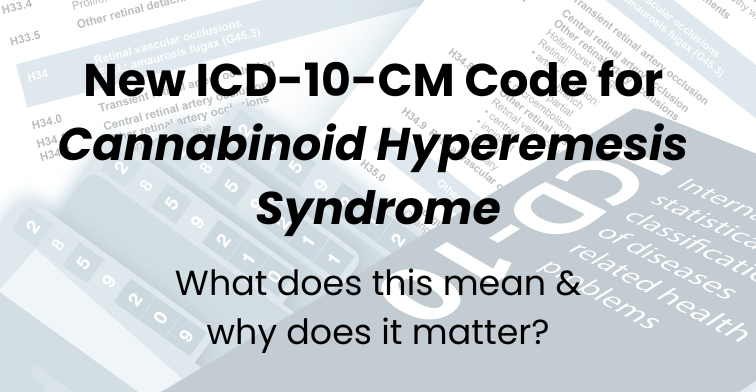New ICD-10-CM Code for Cannabinoid Hyperemesis Syndrome: R11.16
10/17/2025
A new ICD-10-CM diagnosis code for Cannabinoid Hyperemesis Syndrome (CHS) went into effect on October 1, 2025.
ICD-10-CM codes are used to classify different medical diagnoses, symptoms, and procedures in health records and for billing and claims processing.
To date, most health systems have documented CHS using a combination of codes for nausea and vomiting, such as R11.2, and a second code indicating cannabis use or cannabis use disorder.
With the new code, a direct diagnosis for patients with CHS can be recorded, which will help with monitoring and treatment of the condition, as well as make it easier for researchers to collect data for public health research on cannabis-related health issues.
CHS is an increasingly recognized complication of frequent and long-term cannabis use, characterized by intense abdominal pain and recurrent episodes of nausea and intense vomiting. Symptoms typically begin abruptly within 24 hours of the last cannabis use.
Two studies (see below) published in 2025 have revealed a sharp rise in CHS-related emergency department visits in the U.S.:
- The first reported a 49% annual increase among individuals aged 13–21 between 2016 and 2023.
- The second found a 28.1% annual increase among those aged 15–24 from 2006 to 2020.
The addition of this diagnosis code demonstrates a growing awareness of the unique health conditions linked to cannabis use and can help lead to more support for public health policies and programs related to cannabis use.
This notice was written in collaboration between ADAI and the Snohomish County Health Department.
1.Toce MS, Monuteaux MC, Fishman MD, Hudgins JD. Emergency Department Visits for Cannabis Hyperemesis Syndrome Among Adolescents. JAMA Netw Open. 2025;8(7):e2520492. doi:10.1001/jamanetworkopen.2025.2049
2.Jack B, Susi A, Reeves P, Nylund CM. Increasing trends of cannabinoid hyperemesis syndrome in youth: The grass is not always greener. J Pediatr Gastroenterol Nutr. 2025;80(4):638-643. doi:10.1002/jpn3.12469
In the News
The director of ADAI’s Cannabis Education & Research Program, Beatriz Carlini, PhD, MPH, has been interviewed for a number of news pieces about the new diagnostic code for cannabis hyperemesis syndrome and how it will help with tracking, treating, and studying CHS.
- UW Medicine: Disabling cannabis condition gets formal clinical identity (Brian Donohue, November 18, 2025)
- KOMO News: Syndrome linked to chronic cannabis use gets formal ID by World Health Organization (Stella Sun, November 19, 2025)





